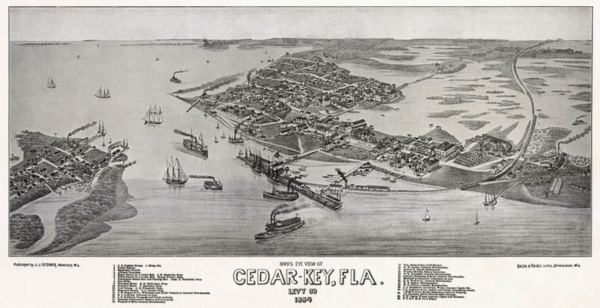Hurricane History of the Cedar Keys
The Cedar Keys is a group of islands off the Florida Big Bend. You will hear a lot about it over the next 36 hours.
An Army depot was established in 1836 on Depot Key. It was abandoned after a devastating hurricane in 1842.
The area began to develop commercially. Cedar Key rose became an important seaport for cotton, sugar, tobacco and lumber coming down the Suwanee River into the Gulf. The Eberhard Faber pencil mill was established on Atsena Otie Key (the old Depot Key).
Eagle Pencil also had a mill on Way Key. A railroad was established between Fernandina and Cedar Key, increasing the seaport’s value.
The Civil War left the Keys in ruins, but within a few years, an economic boom was underway. The town of Cedar Key was incorporated on the old Way Key. But as fast as it had risen, the area began to decline. The city of Tampa was pulling shipping activity away from the Keys.
Then, a major hurricane struck the Cedar Keys on the morning of September 29th with a ten foot storm surge. Headlines screamed, “Cedar Key Crushed,” and “Town Almost Wiped Out.” The hurricane devastated the Eberhard Faber and Eagle mills.
The mills were not rebuilt after the hurricane. The town of Atsena Otie was so badly damaged that it was not rebuilt.
Even without the devastating effects of the hurricane, the timber industry on Cedar Key was in big trouble. Without any thought to conservation or replanting, the valuable cedar resource was being used up. The economic loss of the plants was staggering.
One additional industry did rise on Cedar Key. The Standard Manufacturing Company was established in 1910. The company produced high quality brushes and would stay in operation until the factory was essentially destroyed in the 1950 hurricane.
That hurricane, named Easy, passed Tampa on the 4th and slowed to nearly a stop. As Easy sat over the warm Gulf waters, it slowly intensified, making a slow counter-clockwise loop before crossing the coast south of Cedar Key on the morning of the 5th.
The erratic hurricane made another loop, circling around Cedar Key. The storm then passed out over the Gulf again. Its final landfall would occur near Homosassa Springs.
The storm pounded the Cedar Key area with hurricane force winds, extremely high tides and torrential rains for over 18 hours. It was the worst storm in the town’s history, with winds recorded to 125 mph before the anemometer blew away.
The barometer reading of 28.30 inches. An official 24 inch rain gauge overflowed and an amazing 38.70 inches of rain was recorded in just 24 hours at Yankeetown, Florida to set the state’s record. Yankeetown was in the eye of the storm for an amazing five hours.
Every building in the town was damaged. One hundred fifty homes and buildings lost their roofs. High tides isolated the island for 2 ½ days. One hundred fishing boats were destroyed. Three people died. Damage totaled $3.3 million.
The economic infrastructure of Cedar Kay was decimated. The town’s employer, Standard Fiber, a maker of brooms and brushes, had its plant severely damaged. It would close two years later.
Today, Cedar Key is a resort and artists colony and fishing village. There has not been a major hurricane there since Easy in 1950. Hopefully it will come through relatively unscathed. I fear a different outcome for the beautiful spot and the Nature Coast of Florida.
Category: ALL POSTS, Headlines, Met 101/Weather History, Tropical
















